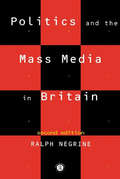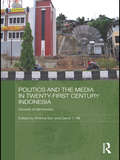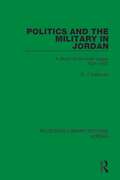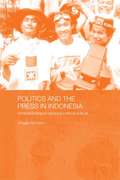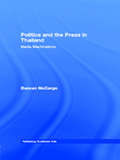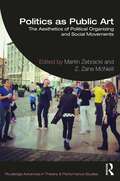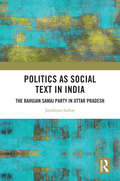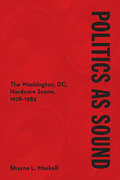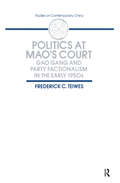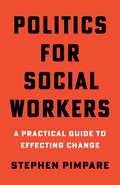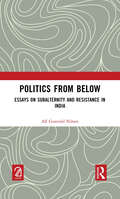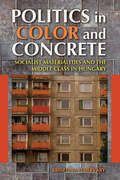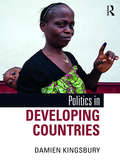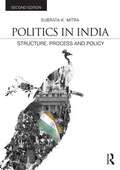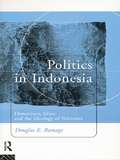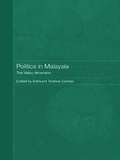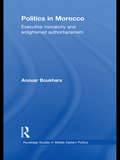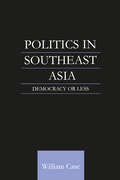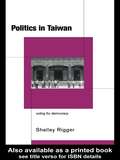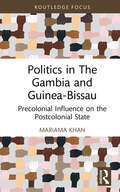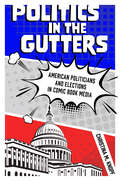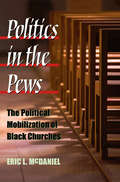- Table View
- List View
Politics and the Mass Media in Britain
by Ralph NegrineThis fully-updated new edition of Politics and the Mass Media provides a comprehensive introduction to the role of mass communications in politics at all levels, from election campaigns, news reports and lobbying groups to the media activities of pressure groups.The relationship between politics, politicians and the media is a matter of increasingly contentious debate, as politicians' awareness of the importance of the media becomes more sophisticated amidst rapidly-advancing media technology and control.Providing a review of the nature and content of political communications and of recent theoretical developments, Negrine addresses the issues surrounding today's mass media, including cable and satellite television, investigation of the press, the relationship between the state and broadcasing institutions and the ever-present question of whether or not Britain needs a media policy. This new edition includes:* Case studies from television and the press* Fully revised text with updated sections on the press, broadcasting and media legislation* Brand new chapters on Europe and globalisation
Politics and the Media in Twenty-First Century Indonesia: Decade of Democracy (Media, Culture and Social Change in Asia)
by Krishna SenEvery political aspirant and activist knows the media are important. But there is little agreement on how an increasingly diversified media operate in post-authoritarian transitions and how they might promote, or impede, the pathways to a sustainable liberal democracy in the 21st century. This book examines the role of the media during Indonesia’s longest experiment with democratisation. It addresses two important and related questions: how is the media being transformed, both in terms of its structure and content, by the changing political economy of Indonesia after the fall of Suharto? And what is the potential impact of this media in enabling or hampering the development of democracy in Indonesia? The book explores the relation between the working of democratisation, by examining the role of ethnic identity and nationalism; increasingly cheaper and diversified means of media production, challenging state monopolies of the media; the reality of personalised and globalised media; and the challenging of the connection between a free media and democracy by global capitalism and corporate control of the media. The book argues that the dominant forces transforming Indonesia today did not arise from the singular point of Suharto’s resignation, but from a set of factors which are independent from, but linked to, Indonesia’s internal politics and which shape its cultural industries.
Politics and the Military in Jordan: A Study of the Arab Legion, 1921-1957 (Routledge Library Editions: Jordan #4)
by P.J. VatikiotisAmidst the turmoil in the Middle East, Jordan has presented a striking example of relative stability, and in this study, first published in 1967, Professor Vatikiotis sets out to show just how far Jordan’s stability depends on its army. The Jordan Arab Army, for long better known as the Arab Legion, was one of the best small fighting forces in the Middle East. Raised in 1921 by the late King Abdullah, the legion helped him to pacify the tribes and establish and extend his rule and authority over a fractious society in a region of vast desert expanses. The Legion then expanded into a disciplined military institution, but whereas the armies of several Arab states were involved in coups, the Jordan Arab Army has no such record. In this book, the author examines the particular historical conditions from which a state emerged in Jordan, and the role of the Arab Legion in its creation and consolidation.
Politics and the Press in Indonesia: Understanding an Evolving Political Culture
by Angela RomanoThis book explores the evolving political culture in Indonesia, by discussing the country's dominant political philosophies, then showing how those philosophies affect the working lives of ordinary Indonesian citizens. It focuses in particular on the working lives of news journalists, a group that occupies a strategic social and political position.
Politics and the Press in Thailand: Media Machinations (Rethinking Southeast Asia #Vol. 1)
by Duncan McCargoThis is the first book in the English language to examine the tangled web of relationships linking newspaper owners, editors and reporters, with leading politicians and power-holders. Duncan McCargo has been granted unique access to the editorial meetings of Thailand's leading newspapers, and drawing on this, the book uncovers the contradictions and dichotomies which underlie political coverage in the Thai press.
Politics as Public Art: The Aesthetics of Political Organizing and Social Movements (Routledge Advances in Theatre & Performance Studies)
by Martin Zebracki Z. Zane McNeillPolitics as Public Art presents a keystone collection that pursues new frameworks for a critical understanding of the relationship between public art and protest movements through the utilization of socially engaged and choreopolitical approaches. This anthology draws from a unique combination of interdisciplinary scholarship and activism where it integrates geographically rich perspectives from political and grassroots community contexts spanning the United States, Europe, Australia, and Southeastern Africa. The volume questions, and reimagines, not only how public art practice can be integral to politics, including forms of surveillance and control of bodily movement. It also probes into how political participation itself can be construed as a form of public artmaking for radical social change and just worlds. This collection advocates for scholar-activist inquiry into how socially engaged public art practices can pave the way for thinking through—and working toward—championing more inclusive futures and, as such, choreographing greater intersectional justice. This book provides a wide appeal to audiences across humanities and social science scholarship, arts practice, and activism seeking conceptual and empirically informed tools for moving from public art and choreopolitical theory into modes of praxis: critical reflection and action.
Politics as Social Text in India: The Bahujan Samaj Party in Uttar Pradesh
by Jayabrata SarkarThis book explores the emergence of the Bahujan Samaj Party (BSP) as an alternative political force in Uttar Pradesh. It focuses on the historical continuity of Dalit social justice movements and organizational politics from pre- to post-colonial India and its subsequent institutionalization as a political force with the rise of the BSP in the state since the 1980s. The volume discusses the new age Dalit–Bahujan politics and its ethnicization of caste groups to create a bahujan samaj. The book analyzes the focused political leadership of Kanshiram and Mayawati, the strong party organization, and how they evolved an empowered Dalit ideology and identity by grassroots mobilization and championing Dalit icons and history. The author also explores the party’s strategies, slogans and alliances with other political parties and communities and its political manoeuvrings to retain its influence over the electorate. The book also effectively identifies the reasons for the political marginalization of the BSP in present times in the context of the phenomenal rise of the BJP in the state. The book will be of great interest to researchers and scholars of political science, sociology, Dalit and subaltern studies, exclusion studies and those working on the intersectionality of caste and class. It will also be useful for policy makers, think tanks and NGOs working in the domain of caste, marginality, social exclusion and identity politics.
Politics as Sound: The Washington, DC, Hardcore Scene, 1978-1983 (Music in American Life)
by Shayna MaskellUncompromising and innovative, hardcore punk in Washington, DC, birthed a new sound and nurtured a vibrant subculture aimed at a specific segment of the city's youth. Shayna L. Maskell explores DC's hardcore scene during its short but storied peak. Led by bands like Bad Brains and Minor Threat, hardcore in the nation's capital unleashed music as angry and loud as it was fast and minimalistic. Maskell examines the music's aesthetics and the unique impact of DC's sociopolitical realities on the sound and the scene that emerged. As she shows, aspects of the music's structure merged with how bands performed it to put across distinctive representations of race, class, and gender. But those representations could be as complicated and contradictory as they were explicit. A fascinating analysis of a punk rock hotbed, Politics as Sound tells the story of how a generation created music that produced--and resisted--politics and power.
Politics at Mao's Court: Gao Gang and Party Factionalism in the Early 1950s
by Frederick C TeiwesThe investigation of the rise and fall of Gao Gang suggests broader implications on the nature of elite politics in the Maoist era. The illumination of basic issues in Chinese politics in the context of this case, especially as regards the role of Mao Zedong, is relevant not only to the initial post-1949 period of comparative, but flawed, party unity, but also to the structural fault lines of the political system which were later to contribute so significantly to the Cultural Revolution.
Politics for Social Workers: A Practical Guide to Effecting Change
by Stephen PimpareThe social work profession calls on its members to strive for social justice. It asks aspiring and practicing social workers to advocate for political change and take part in political action on behalf of marginalized people and groups. Yet this macro goal is often left on the back burner as the day-to-day struggles of working directly with clients take precedence. And while most social workers have firsthand knowledge of how public policy neglects or outright harms society’s most vulnerable, too few have training in the political processes that created these policies.This book is a concise, accessible guide to help social workers understand how politics and policy making really work—and what they can do to help their clients and their communities. Helping readers develop sustainable strategies at the micro-, meso-, and macro-levels, this book is a hands-on manual to contemporary American politics, showing social workers and social work students how to engage in effective activism. Stephen Pimpare, a political scientist with extensive experience as a social work practitioner and instructor, offers informed, practical grounding in the mechanics of policy making and the tools that activists and outsiders can use to take on an entrenched system. He distills key research and insights from political science and related disciplines into a practical resource for social work students, instructors, and practitioners looking to deepen their policy knowledge and capacity to achieve change.
Politics for the Love of Fandom: Fan-Based Citizenship in a Digital World
by Ashley HinckPolitics for the Love of Fandom examines what Ashley Hinck calls “fan-based citizenship”: civic action that blends with and arises from participation in fandom and commitment to a fan-object. Examining cases like Harry Potter fans fighting for fair trade, YouTube fans donating money to charity, and football fans volunteering to mentor local youth, Hinck argues that fan-based citizenship has created new civic practices wherein popular culture may play as large a role in generating social action as traditional political institutions such as the Democratic Party or the Catholic Church. In an increasingly digital world, individuals can easily move among many institutions and groups. They can choose from more people and organizations than ever to inspire their civic actions—even the fandom for children's book series Harry Potter can become a foundation for involvement in political life and social activism. Hinck explores this new kind of engagement and its implications for politics and citizenships, through case studies that encompass fandoms for sports, YouTube channels, movies, and even toys. She considers the ways in which fan-based social engagement arises organically, from fan communities seeking to change their world as a group, as well as the methods creators use to leverage their fans to take social action. The modern shift to networked, fluid communities, Hinck argues, opens up opportunities for public participation that occurs outside of political parties, houses of worship, and organizations for social action. Fan-based citizenship performances help us understand the future possibilities of public engagement, as fans and creators alike tie the ethical frameworks of fan-objects to desired social goal, such as volunteering for political candidates, mentoring at-risk youth, and promoting environmentally friendly policy. Politics for the Love of Fandom examines the communication at the center of these civic actions, exploring how fans, nonprofits, and media companies manage to connect internet-based fandom with public issues.
Politics from Below: Essays on Subalternity and Resistance in India
by Alf Gunvald NilsenThis book is a collection of essays that question how subalternity is constituted and contested in Indian society. It draws on Antonio Gramsci's work to investigate the dynamics of hegemony, subalternity and resistance in India, both past and present. Drawing on the author's extensive fieldwork, Politics from Below presents detailed ethnographic studies of the movement against dam building in the Narmada Valley and Adivasi mobilization to democratize the local state in western India. The book will be relevant to students and scholars with an interest in social movements and the political economy of development and democracy in India, as well as to activists and engaged members of the public more generally. This title is co-published with Aakar Books. Print editions not for sale in South Asia (India, Sri Lanka, Nepal, Bangladesh, Pakistan and Bhutan)
Politics in China since 1949: Legitimizing Authoritarian Rule (Routledge Contemporary China Series #Vol. 11)
by Robert WeatherleySince the victory of the 1949 revolution the incumbency of the Chinese Communist Party has been characterized by an almost relentless struggle to legitimize its monopoly on political power. During the Mao era, attempts to derive legitimacy focused primarily on mass participation in political affairs, a blend of Marxist and nationalist ideology, and the charismatic authority of Mao Zedong. The dramatic failure of the Cultural Revolution forced the post-Mao leadership to discard these discredited paradigms of legitimacy and move towards an almost exclusively performance based concept founded on market economic reform. The reforms during the 1980s generated a number of unwelcome but inevitable side effects such as official corruption, high unemployment and significant socio-economic inequality. These factors culminated ultimately in the 1989 demonstrations in Tiananmen Square and throughout China. Since Tiananmen the party has sought to diversify the basis of its legitimacy by adhering more closely to constitutional procedures in decision making and, to a certain extent, by reinventing itself as a conservative nationalist party. This probing study of post-communist revolution Chinese politics sets out to discover if there is a plausible alternative to the electoral mode or if legitimacy is the exclusive domain of the multi-party system.
Politics in Color and Concrete: Socialist Materialities and the Middle Class in Hungary (New Anthropologies of Europe)
by Krisztina FehérváryA historical anthropology of material transformations of homes in Hungary from the 1950s o the 1990s.Material culture in Eastern Europe under state socialism is remembered as uniformly gray, shabby, and monotonous—the worst of postwar modernist architecture and design. Politics in Color and Concrete revisits this history by exploring domestic space in Hungary from the 1950s through the 1990s and reconstructs the multi-textured and politicized aesthetics of daily life through the objects, spaces, and colors that made up this lived environment. Krisztina Féherváry shows that contemporary standards of living and ideas about normalcy have roots in late socialist consumer culture and are not merely products of postsocialist transitions or neoliberalism. This engaging study decenters conventional perspectives on consumer capitalism, home ownership, and citizenship in the new Europe.“A major reinterpretation of Soviet-style socialism and an innovative model for analyzing consumption.” —Katherine Verdery, The Graduate Center, City University of New York“Politics in Color and Concrete explains why the everyday is important, and shows why domestic aesthetics embody a crucially significant politics.” —Judith Farquhar, University of Chicago“The topic is extremely timely and relevant; the writing is lucid and thorough; the theory is complex and sophisticated without being overly dense, or daunting. I thoroughly enjoyed reading it.” —Brad Weiss, College of William and Mary
Politics in Contemporary Indonesia: Institutional Change, Policy Challenges and Democratic Decline
by Dirk Tomsa Ken M.P SetiawanIn Politics in Contemporary Indonesia, Ken M.P. Setiawan and Dirk Tomsa analyse the most prominent political ideas, institutions, interests and issues that shape Indonesian politics today. Guided by the overarching question whether Indonesia still deserves its famous label as a ‘model Muslim democracy’, the book argues that the most serious threats to Indonesian democracy emanate from the fading appeal of democracy as a compelling narrative, the increasingly brazen capture of democratic institutions by predatory interests, and the narrowing public space for those who seek to defend the values of democracy. In so doing, the book answers the following key questions: What are the dominant political narratives that underpin Indonesian politics? How has Indonesia’s institutional framework evolved since the onset of democratisation in 1998? How do competing political interests weaken or strengthen Indonesian democracy? How does declining democracy affect Indonesia’s prospects for dealing with its main policy challenges? How does Indonesia compare to other Muslim-majority states and to its regional neighbours? Up-to-date, comprehensive and written in an accessible style, this book will be of interest for both students and scholars of Indonesian politics, Asian Studies, Comparative Politics and International Relations.
Politics in Developing Countries
by Damien KingsburyPolitics in Developing Countries provides a clear and reader-friendly introduction to the key factors and themes that shape political processes in developing countries. Achieving development outcomes such as reducing poverty and inequality is only possible through efficient governance, well-planned policies and careful allocation of resources, but often politics in developing countries has been identified with mismanagement, corruption, conflict and repression of dissent. This book assesses the politics of developing countries in the period since decolonisation, focusing on the ways in which states have or have not worked to the advancement of their citizens’ interests. Key topics include: Colonialism and its legacy Ethnicity and nation building Governance, corruption and the role of the state Poverty and the political economy of development Aid and outside influence. Drawing on a range of case studies from around the world, Politics in Developing Countries looks at the consistencies and variations between developing countries, examining why some have forestalled political change by liberalising their economies, and others have actively stifled calls for change. Wide-ranging and engagingly written, this introductory textbook is perfect for students of politics and international development, as well as for those with a general interest in the challenges faced by countries in the Global South.
Politics in India: Structure, Process and Policy (Moderne Sudasienstudien / Modern South Asian Studies #5)
by Subrata K. MitraThe second edition of this textbook brings together general political theory and the comparative method to interpret socio-political phenomena and issues that have occupied the Indian state and society since 1947. It considers the progress that India has made in some of the most challenging aspects of post-colonial politics such as governance, democracy, economic growth, welfare, and citizenship. Looking at the changed global role of India, its standing in the G-20 and BRICS, as well as the implications of the 2014 Indian general elections for state and society, this updated edition also includes sections on the changing socio-political status of women in India, corruption and terrorism. The author raises several key questions relevant to Indian politics, including: • Why has India succeeded in making a relatively peaceful transition from colonial rule to a resilient, multi-party democracy in contrast to its South Asian neighbours? • How has the interaction of modern politics and traditional society contributed to the resilience of post-colonial democracy? • How did India’s economy moribund—for several decades following Independence—make a breakthrough into rapid growth and can India sustain it? • And finally, why have collective identity and nationhood emerged as the core issues for India in the twenty-first century and with what implications for Indian democracy? The textbook goes beyond India by asking about the implications of the Indian case for the general and comparative theory of the post-colonial state. The factors which might have caused failures in democracy and governance are analysed and incorporated as variables into a model of democratic governance. In addition to pedagogical features such as text boxes, a set of further readings is provided to guide readers who wish to go beyond the remit of this text. The book will be essential reading for undergraduate students and researchers in South Asian and Asian studies, political science, development studies, sociology, comparative politics and political theory.
Politics in Indonesia: Democracy, Islam and the Ideology of Tolerance (Politics in Asia)
by Douglas E. RamagePolitics in Indonesia describes the attitudes, aspirations and frustrations of the key players in Indonesian politics as they struggle to shape the future. The book focuses on the role of political Islam; Douglas E. Ramage shows that the state has been remarkably successful in maintaining secular political institutions in a predominantly Muslim society. He analyses the way in which political questions are framed with reference to the national ideology, the Pancasila.
Politics in Malaysia: The Malay Dimension (Routledge Malaysian Studies Series #3)
by Edmund Terence GomezExamining some of the most critical issues in Malaysian politics today, including human rights, law and democracy, gender and Islam, this book explores the contours of the contemporary landscape of Malaysian politics, focusing especially on politics among the majority ethnic Malay community. In particular, the book explains why changes in patterns of political mobilization and the rhetoric of the dominant parties - particularly the PAS and UMNO - have been so limited, despite the overt and growing dissatisfaction shown by Malaysians with the state of their political system and the ability of these parties to represent their interests. It considers the recent history of events and discourses within Malaysian society, and UMNO and PAS, and goes on to analyze why important transitions have occurred in society yet political parties have not adapted themselves to these changes and remained reticent about instituting meaningful reforms involving these matters.
Politics in Morocco: Executive Monarchy and Enlightened Authoritarianism (Routledge Studies in Middle Eastern Politics)
by Anouar BoukharsDemocratization and the process of political reform is a critical issue in the contemporary Middle East and North Africa. This book looks at the situation in Morocco and examines the role of the monarchy and the relative strengths and weaknesses of the Islamic and secular/liberal groupings campaigning to shape the local politics and society. Politics in Morocco moves beyond the theoretical framework of the transition paradigm to give a thorough analysis of the dynamics of monarchical authoritarian rule and its implications. The author explores the formal and informal working mechanisms of authoritarian rule, the roles and functions of secular opposition forces, and the dynamics of political inclusion of Islamists in the structures of formal contestation. In doing so, he sheds fresh light on how authoritarian rule under King Mohamed VI is maintained and legitimised by a wide array of formal and informal political and social networks. This in-depth investigation of political participation in Morocco offers a new perspective on the issue of democracy and monarchical rule in the Middle East. As such, it will be of great interest to students and scholars of Middle Eastern and North African politics, democratization studies and political Islam.
Politics in Southeast Asia: Democracy or Less
by William CaseThis volume provides an introduction to the politics of the five key southeast Asian states - Malaysia, Singapore, Indonesia, Thailand and the Philippines - and is intended as a textbook for undergraduate and graduate students taking courses on this subject. Using a comparative politics and political economy perspective, the author focuses in particular on the degree of democracy in the five countries, arguing that in all the countries considered democracy is, to varying degrees, imperfect. The book synthesises a wide range of scholarship, and presents the material in a concise and accessible way.
Politics in Taiwan: Voting for Reform
by Shelley RiggerThis book shows that Taiwan, unlike other countries, avoided serious economic disruption and social conflict, and arrived at its goal of multi-party competition with little blood shed. Nonetheless, this survey reveals that for those who imagine democracy to be the panacea for every social, economic and political ill, Taiwan's continuing struggles against corruption, isolation and division offer a cautionary lesson.This book is an ideal, one-stop resource for undergraduate and postgraduate students of political science, particuarly those interested in the international politics of China, and the Asia-Pacific.
Politics in The Gambia and Guinea-Bissau: Precolonial Influence on the Postcolonial State (Routledge Studies in African Development)
by Mariama KhanThis book explores how precolonial political traditions and practices shape modern-day politics in The Gambia and Guinea-Bissau. The precolonial Kaabu empire dominated the region for over 300 years, leaving a rich oral and ritual culture that emphasized the importance of a ruler’s legitimacy among the general population. This book traces how postcolonial political administrations and Justice, Integrity and Truth (JIT) movements have mobilized to reclaim, reinvent and subvert traditional Kabunka norms of statecraft to prove their political legitimacy. It shows how cultural memory, oral arts and musical forms can be used to express ideals of leadership and followership and, in the process, create various conversations and debates about politics and society, social attitudes and morality. In doing so, the book captures how the latent but influential social and political practices from Kaabu are reclaimed, reproduced or subverted to contribute to the evolving nature of political rhetoric in these two countries. Whereas many studies of the state in Africa take Western democratic principles as a starting point, this book provides important evidence on the continuity of precolonial political culture along African’s west coast. It will be of interest to researchers studying politics, history and anthropology both within the region and elsewhere in Africa.
Politics in the Gutters: American Politicians and Elections in Comic Book Media
by Christina M. KnopfFrom the moment Captain America punched Hitler in the jaw, comic books have always been political, and whether it is Marvel’s chairman Ike Perlmutter making a campaign contribution to Donald Trump in 2016 or Marvel’s character Howard the Duck running for president during America’s bicentennial in 1976, the politics of comics have overlapped with the politics of campaigns and governance. Pop culture opens avenues for people to declare their participation in a collective project and helps them to shape their understandings of civic responsibility, leadership, communal history, and present concerns.Politics in the Gutters: American Politicians and Elections in Comic Book Media opens with an examination of campaign comic books used by the likes of Herbert Hoover and Harry S. Truman, follows the rise of political counterculture comix of the 1960s, and continues on to the graphic novel version of the 9/11 Report and the cottage industry of Sarah Palin comics. It ends with a consideration of comparisons to Donald Trump as a supervillain and a look at comics connections to the pandemic and protests that marked the 2020 election year. More than just escapist entertainment, comics offer a popular yet complicated vision of the American political tableau. Politics in the Gutters considers the political myths, moments, and mimeses, in comic books—from nonfiction to science fiction, superhero to supernatural, serious to satirical, golden age to present day—to consider how they represent, re-present, underpin, and/or undermine ideas and ideals about American electoral politics.
Politics in the Pews: The Political Mobilization of Black Churches
by Mcdaniel Eric L."Politics in the Pewsprobes the internal dynamics of political decision making within the Black church. " ---William E. Nelson, Jr. , Research Professor, Department of African American and African Studies, Ohio State University As Eric McDaniel demonstrates in his study of Black congregations in the U. S. , a church's activism results from complex negotiations between the pastor and the congregation. The church's traditions, its institutional organization, and its cultural traditions influence the choice to make politics part of the church's mission. The needs of the local community and opportunities to vote, lobby, campaign, or protest are also significant factors. By probing the dynamics of churches as social groups, McDaniel opens new perspectives on civil rights history and the evangelical politics of the twenty-first century. Politics in the Pewscontributes to a clearer understanding of the forces that motivate any organization, religious or otherwise, to engage in politics. Eric L. McDaniel is Assistant Professor in the Department of Government at the University of Texas at Austin.
